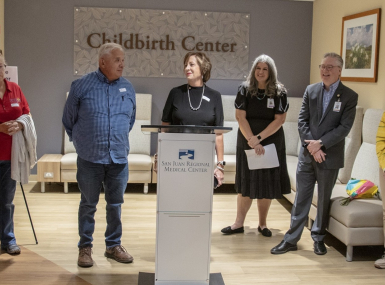Triumph over NIMBY attitudes is not only possible, but necessary
Upcoming Events
Related News

To combat NIMBY sentiments regarding affordable housing, engage community early and often, find champions, show benefits, address concerns, be available
Across the nation, communities of all shapes and sizes are literally waking up to the reality that finding a home that is affordable is more difficult than ever before. This is in part because the nation’s housing stock has not kept up with the demand. According to data shared by The Wall Street Journal last month, we are simply not building enough housing to keep up with economic growth, and the lack of housing (especially housing that is affordable to low- and moderate-income families), is stifling. Some reports suggest that we have a national shortage of 7.3 million units to meet that demand.
With supply so low but demand so high, we are seeing fierce battles playing out in counties all across the country over who gets to live where and why. Where do we add density? Where can we rezone to support the creation of new housing? And in high-cost housing cities, where can we preserve what little affordable housing is left to ensure that we do not edge out all but the wealthiest residents?
Those battles — often between local community residents and housing developers (especially those trying to create or preserve affordable housing) often land at the feet of public officials (county commissioners, executives, their staffs and other local policymakers). With tensions running high, housing advocates have had to get much more creative in ameliorating the concerns of residents — often expressed in terms of parking needs, traffic congestion caused by increased density, community growth that is out of sync with the character of the neighborhood or the view of the skyline that may be impacted by the new housing development across the street.
The good news is that over the last few decades, as these conflicts have gotten much more fierce and frequent, and we’ve seen many primers on community opposition emerge with a long litany of recommendations mostly aimed at helping developers overcome NIMBY — not in my backyard — sentiments. Most of those recommendations center on a couple simple ideas.
— Engage the community early and often, as the development plans emerge and get refined.
— Recruit and mobilize community champions who will help to “sell” the idea to their friends and neighbors.
— Develop materials that highlight the shared benefits that the community will enjoy because of the development but be careful not to over-promise.
— Address legitimate concerns that community residents make (things like the location of the entrance driveway or the design of the building to better fit in with the existing community).
— Share the plans for the development and provide examples of past projects so that residents can appreciate the quality.
— Establish a point of contact on your development team and make that person visible and available to the community.
— Know when to give up; simply put, some communities have the resources to slow the pace of the development for years — grinding any potential profits into the ground.
This is not an exhaustive list of recommendations but it represents those in heaviest rotation in the playbooks circulated to help developers successfully navigate the challenges of community opposition.
When communities oppose affordable housing developments, it means that much of the housing stock that needs to be replenished, updated or expanded — housing that would help ease the cost burdens being deeply felt in our counties — simply never gets built. And it never gets built even when developers have taken the steps to engage the surrounding communities early in the planning process.
The siting of affordable housing represents a particularly tough roadblock for county officials who must also navigate the community clashes that ensue as well as attempt to garner public support for county programs that are geared toward creating housing options for low- and moderate-income families. Despite the severe shortage of housing in many of our communities, it can be a tough task to enlist the public’s support and to help county leadership stay committed.
To change these circumstances, we need to be especially thoughtful and strategic in how we address the locus of these conflicts. In a paper that I co-authored last fall on housing messaging, we presented research showing how housing advocates’ attempts to lift policy solutions — especially those solutions that require local government support, intervention, mandates or funding — often backfire with public audiences.
My co-author and I outlined a series of other common backfires and made specific recommendations for communications practice to build public support. As we state in that paper: “The work to build the public will to address housing challenges may be even tougher than many realize.
Our experience and research show that, while advocates are lifting up policy and programmatic solutions, we are missing the opportunity to change the narrative about why housing matters; what “affordable housing” means; why housing is a shared public concern; and what needs to be done to fix this problem.”
Reframing the conversation about housing means changing the way that we invite a more thoughtful public conversation. Of these 10 recommendations that we make in the paper, three are briefly introduced here.
1. Help people to see how support for affordable housing benefits them. Our task is to widen the public’s understanding of who benefits from affordable housing and to help people see how they benefit from such developments. Useful to this effort is building a case for inclusion, based on clear messages about the economic benefits to the whole community, the negative impacts from restrictive local housing policies on all home values and regional economic growth, as well as the talent communities are excluding when they limit access to opportunity.
2. Help people to see their stake in prioritizing this issue. Our task is to develop messaging that emphasizes how policies such as low-density zoning (which communities often use to exclude affordable housing developments from their neighborhoods) hurts the regional economy by limiting population growth, restricting the growth of the workforce, limiting the development of the necessary infrastructure to grow economic capacity, and pushing out firms who want (and need to) grow. In essence, we need to help people see that affordable housing helps us meet the needs of the economy that is coming and is the smart thing to do to ensure that our cities prosper, in addition to being the “right” thing to do.
3. Connect housing to the wide range of other social issues that are priorities for residents in your county. Connecting the expansion of housing to other issues allows fair housing advocates to align with advocates in education, health, labor and other issues for stronger advocacy efforts. The latter is incredibly important if we are to raise the salience of housing on the agenda of your county and to create a more favorable climate for expanding support for affordable housing developments, policies, and funding.
Taken together these efforts help us to re-position affordable housing as a shared public concern with collective benefits for a wide range of people who may not have been able to see themselves as clear beneficiaries. Most of all, reframing our messaging in this way allows us to tell a bigger story about how affordable housing affects all of us and to widen the circle of support in our counties.
Attachments
Related News

Now I know I can adapt my communication style
San Juan County, N.M. Commissioner Terri Fortner spent her career working with people one-on-one, but she overcame hangups about online communication when the pandemic forced her onto video calls when she first took office.

County service meets a veteran’s need for purpose in Spotsylvania County, Virginia
After Drew Mullins transitioned from a high-performance lifestyle in the military, he found the environment and purpose he sought when he took office in his county.
Now I know that solid waste is complicated
Custer County, Idaho Commissioner Will Naillon says solid waste removal is "one of the things that people often take for granted until it’s their job to make sure it happens... that’s the story of being a county commissioner."